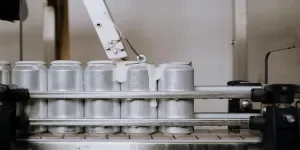Smart packaging is an emerging innovation that integrates new technologies, such as embedded sensors, into the packaging systems. Brands are increasingly using QR codes in smart packaging to make it interactive and improve customer experience. Scanning QR codes gives customers real-time access to the product or brand information.
The growing popularity of QR codes in smart packaging was evidenced in a study that found that 84% of mobile users have scanned a QR code at least once, 72% scan a QR code at least once per month, and 32% once weekly.
This guide will show businesses how to leverage QR codes in smart packaging to enhance brand authenticity and transparency, building customer trust and loyalty.
Table of Contents
The growing market for smart packaging with QR codes
Top 5 ways QR codes are adding value to smart packaging
Types of target customers
Conclusion
The growing market for smart packaging with QR codes
Smart packaging is disrupting the traditional packaging model and creating more value. It is achieving this by integrating digital technology, including QR codes, in the packaging design to provide additional functionality, including tracking products across the supply chain. Besides this, smart packaging with QR codes boosts engagement and interactions with customers.
Market size and potential
The smart packaging market is projected to grow at an annual average rate of 5.9%, reaching US$ 7.56 billion by 2023. The adoption of QR codes in smart packaging will contribute to this growth. This is evidenced in research showing that the market value of QR code packaging was US$ 5.3 billion in 2019 and is projected to grow at a compound annual growth rate (CAGR) of 8% in the coming years.
Additionally, the QR code labels market is estimated at US$ 1.3 billion in 2022 and is projected to grow at a CAGR of 8.9% between 2022-29, reaching US$ 2.1 billion by 2027. The ongoing digital transformation and access to smartphones are accelerating the growth of QR codes in smart packaging, creating opportunities for brands, suppliers, and other investors interested in the industry.
What drives the need for smart packaging QR codes?
Various factors are driving the demand for smart packaging QR codes. These include:
- Improved access to specific product or company information
- Increased personalized engagement with a brand, which improves customer experiences and attitudes towards the brand
- Increased product transparency
- Improved product validation and identification to ensure customers purchase from legitimate brands
Top 5 ways QR codes are adding value to smart packaging
Using QR codes in smart packaging adds value by adding functionalities that improve customer experience and engagement. For instance, improved access to additional product information through scanning of QR codes improves customer experience and can potentially influence purchasing intentions and long-term commitment.
Below are five other ways QR codes are adding value to smart packaging:
QR codes for traceability
QR codes provide an effective way to trace and track products. They provide advanced features that enhance the brand’s real-time ability to track individual products through the supply chain. In addition, QR codes in smart packaging provide customers access to critical product information such as a product’s origin, ingredients, sourcing information, allergies, and sustainability goals.
A study found 94% of consumers are more likely to be loyal to a transparent brand, while 73% are more likely to pay more for transparency. Thus, brands can leverage this innovation to improve transparency and strengthen corporate competitiveness.
QR codes for product digitalization
Scanning a QR code provides customers access to more information and resources, including product specifications, reviews, tutorials, and customer support. It connects customers to the brand’s social media platforms and websites. QR codes also benefit companies by enabling them to track cross-border sales, product movement and inventory, personalized rewards and incentive campaigns. They can also track and analyze data generated through QR codes to understand customer preferences and behaviors.
QR codes for anti-counterfeiting solutions
QR codes integrated within smart packaging solutions provide a unique identifier that enables easy tracking and verifying of the authenticity of products in real time. In addition, they enable using encrypted data transfer protocols to prevent counterfeiters’ attempts to alter or manipulate product information. Therefore, providing scannable QR codes on smart packaging protects consumers from purchasing fake products.
Dynamic QR codes for data collection and insights
Dynamic QR codes are versatile and can provide critical insights, including supply chain inefficiencies. Companies can leverage them to access data on the number of customers using the QR codes, allowing tracking and analyzing their behaviors and preferences. Data collected regarding the product can be used to improve product safety and performance and reduce the overall theft and damage rate.
Regulatory compliance with QR codes
Recent years have seen increased laws and regulations due to the growing global awareness and concerns regarding sustainability, climate change, and safety. As a result, companies must adhere to local and international regulations, especially strict food standards and carbon emissions. Track-and-trace through QR Codes allows quick access to compliance information and makes locating products in case of contamination, or recall is easy.
Types of target customers
Various customers are using smart packaging with QR codes. They can be categorized either by industry or country.
By industry
1). Food and beverage industry
QR codes on food and beverage packaging have allowed these sectors to thrive. For example, companies use food QR codes to provide access to nutritional information, enhance food traceability, facilitate social media engagement, collect feedback, and share fun recipes. A study found that 57% of consumers have scanned a QR code on food packaging to access more information, while 25% scanned to get a recipe.
2). Hospitality industry
Hotels and restaurants are implementing QR codes to enhance operational efficiency and customer experiences. QR code menus have become common in the US, with approximately 52% of all restaurants have implemented them and 33% of restaurant owners using them to enhance their businesses.
3). Personal care industry
Brands in the cosmetic and beauty industry are embracing QR codes in packaging to enhance their competitiveness in the marketplace. This is because smart packaging with QR codes improves engagement, aids decision-making, and promotes transparency to build trust and loyalty.
By country
1). The United States
A 2021 study found that 45% of Americans used a marketing QR code at least once in 3 months, 54% were aged between 18-29, and 48% were aged 30-44. In addition, 11 million households in the US scanned a QR code in 2020, an increase from 9.76 million households in 2018
2). China
QR code usage is more established in China, with 50% of consumers scanning codes weekly. Besides, QR codes account for 90% of payments in China, and 65% of Chinese consumers consider QR codes on packaging critical in building trust. QR codes in the packaging in china are used in various ways:
- brand rewards and incentives
- re-orders
- authenticity confirmation
- origin traceability
3). India
The rapid growth of digital payments and UPI platforms is accelerating the use of QR codes in India. Approximately 40% of the Indian population uses QR codes, with more than 30 million merchants accepting QR code payments, an increase from 2.5 million merchants 5 years ago.
Conclusion
QR codes make packaging more interactive and increase customer engagement. Brands worldwide recognise their capability to enhance traceability, product digitalization, provide anti-counterfeiting solutions, facilitate data collection and insights, and ensure compliance with local and international laws and standards. Besides this, entrepreneurs must understand that modern customers seek unique, personalized experiences. As a result, integrating QR codes into packaging designs can improve business performance due to improved appeal to customers.



